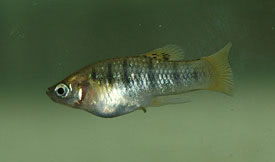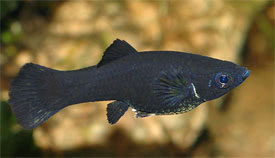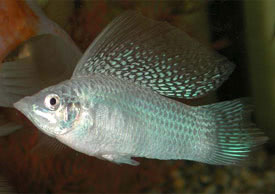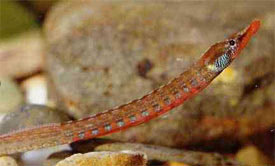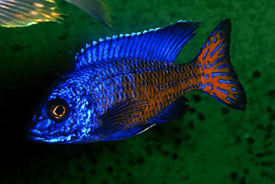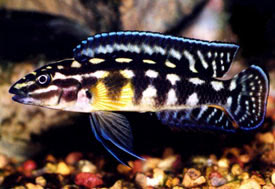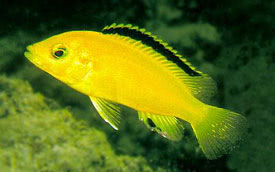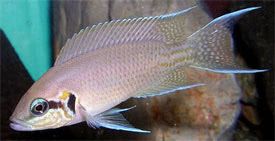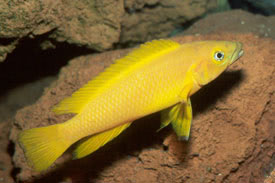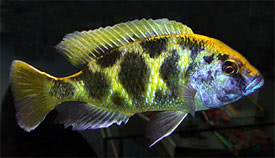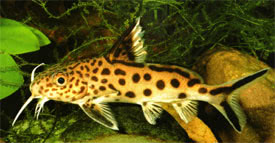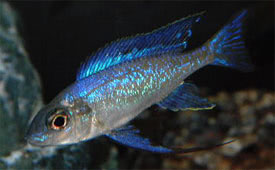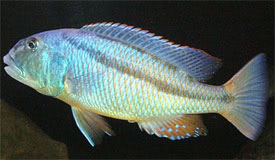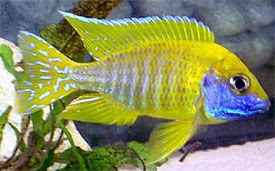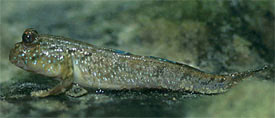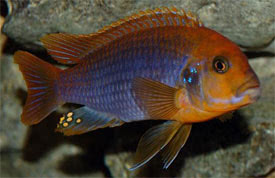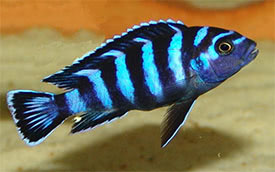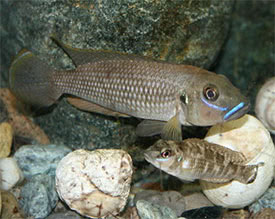
 Magyarul / Hungarian
Magyarul / Hungarian
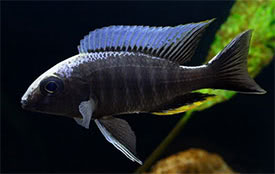

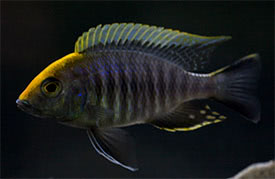

- Scientific name: Aulonocara maylandi
- Synonyms: -
- Common name: Sulphurhead Peacock
- Group: Cichlids
- Habitat: Africa; Lake Malawi
- Size: 10-12 cm
- Biotope: Mainly found in the intermediate zones, where the sand bordering the rocky reef and the water is around 10 metres deep.
- Social behavior: One of the most peaceful member of the genus, yet they should be kept in a species tank. In a larger community tank they can be kept with other non-aggressive fish.
- Diet: Carnivorous; It will take all kind of live, frozen and dried foods. Feeds the same way as the South American Geophagus species: mouthfuls of substrate are taken and sifted for edible foods and the remaining material expelled via the gills and mouth. Some vegetable matter is needed in its diet.
- Breeding: Quite easy
- Tank: Minimum 200 litres
- Population: 5-6 fish for 250 litres
- Decoration: Use rocks to construct structures and caves. but leave some open space between them. Use sand as substrate. The fish will not harm plants so, add tough plants that can tolerate hard water (Anubias).
- Temperature: 25-29 °C
- pH: 7.5-9
- Hardness: 10-30 NK°
- Lifespan: 10 years
Description: Aulonocara maylandi has two color variants, the ‘sulphur head’ variant inhabits West Reef and Eccles Reef, close to Makanjila Point in the southeastern part of the lake, while the form often referred as Aulonocara maylandi kandeensis is known only from Kande Island, just off the central-western shoreline. In the first color variant the males have a bright yellow band running from the tip of the snout to the dorsal part of the body, and the margin of the dorsal fin is also yellow. In the second color variant the males exhibit a similar overall color pattern, but the dorsal stripe is whitish-blue. Since 1987 this color variant is a synonym of Aulonocara maylandi. In both color variants the males have a dark grey body color with dark blue vertical bars. Anal fin has several yellow eggspots. The females have silvery body color with light brown vertical bars. It is important that Aulonocara maylandi should not be kept with other Aulonocara species, as they may hybridise. This species is listed on the IUCN Red List as Vulnerable.
Water quality is the most important issue for them, as they are extremely susceptible to bad water conditions, so never introduce these cichlids to a biologically immature tank. The weekly water changes and an over-filtered aquarium is advisable.
Males are larger and more colorful than females. Sulphurhead Peacock is maternal mouthbrooder. They should be spawn in a harem in a separated tank, with 3-4 females to 1 male, as the male can be aggressive in pursuit of females. Put some flat rocks to the tank, and leave open areas of sand to act as potential spawning sites. Before spawning the male will choose a spawning site and begin to display around it. This is where the females will lay their eggs and then pick them up in their mouths. The male has egg-shaped spots on his anal fin and the female is attracted to these. When she tries to add them to the brood in her mouth she actually recieves sperm from the male, thus fertilising the eggs. The female will carry brood for up to 4 weeks before releasing fully free swimming fry. During this time the female will not eat. The number of the fry can be 60-100. A stressed female may spit the fry prematurely, so they should be raised in a separated tank. The fry can be fed with small live foods, such as brine shrimp nauplii. Sexes can be tell apart at around 4 months of age.







